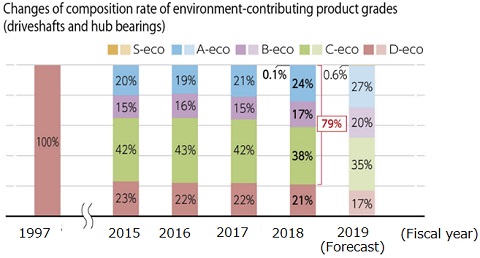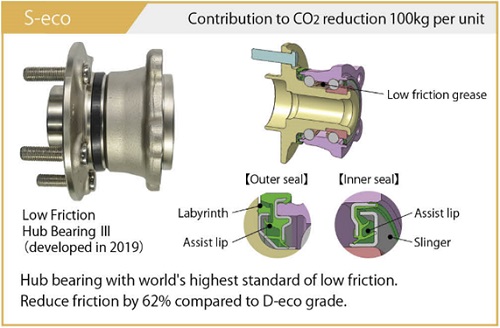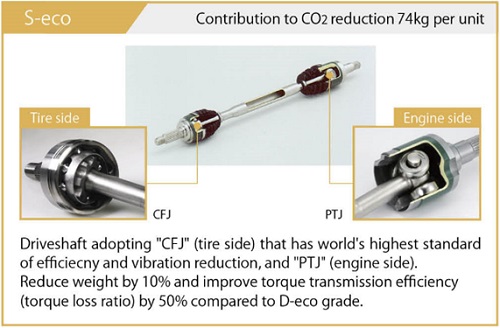Visualizing Environmental Value of Products, Utilizing it for Developing and Supplying New ProductsAugust 22, 2019
Contribute to reducing annual CO2 emissions by approximately 1,400,000 tons compared to 20 years ago
NTN Corporation (hereafter, NTN) have recently begun efforts to quantify the environmental contributions of NTN products to visualize the environmental value of NTN products. By calculating each product's eco-efficiency and comparing it with eco-efficiency of the product in 1997, NTN derives the environmental factors (degree of environmental contribution) for new products developed after 1997. According to the estimates, compared with the case where NTN continued to provide products developed 20 years ago, NTN confirmed that today's products reduce annual CO2 emissions by approximately 1,400,000 tons in fiscal year 2018, which is equivalent to about 600,000 liters of gasoline. NTN will accelerate the development and supply of new environment-contributing products by visualizing the environmental value of its products.
1. Background to establish environmental contribution index
In recent years, climate changes have become a major social issue in the international society, and they are also included in the Sustainable Development Goals (SDGs) advocated by the United Nations. Extreme weather conditions such as heavy rain, drought, and heat waves are observed in various parts of the world. The United Nations published a report in July this year and warned that climate change has been threatening progress toward sustainable development. Further measures to address this global issue are imperative.
NTN manufactures and sells bearings for more than 100 years. Bearing is an eco-friendly product that supports the rotational parts of all machinery and reduces energy consumption by reducing frictions. It can be said that NTN contributes to the energy saving society by manufacturing and selling eco-products. However, NTN has established environmental contribution index to clarify the corporate value of NTN as a supplier among a number of companies, and to accelerate technological developments and improve motivation by developing NTN's quantitative awareness throughout the company.
2. About environmental contribution index
Environmental factors derived from each product are categorized into five grades. Products that contribute to the reduction of energy losses in final products such as automobiles and that have the same level of performance as in 1997 are designated as “D-eco.” Each product is classified into four grades (S-eco, A-eco, B-eco, and C-eco) according to its degree of environmental contributions in comparison with “D-eco.”
In the current fiscal year, NTN quantified the environmental contributions for driveshafts and hub bearings for automobiles, which account for approximately 60% of its net sales. Going forward, NTN will expand the quantification into bearings for industrial machinery and natural energy products.
(1) Class, grade, and definition of NTN products

(2) Calculation method for environmental factors and eco-efficiency

- D-eco product
- Quantify value (including contribution to CO2 reduction in final product) by using QFD method
- Quantify environmental impact as CO2 emmisions generated from mining raw material to production from the view point of evaluating contributions to climate change countermeasures (utilizing “LCI Calculation Tools” by Japan Auto Parts Industries Association (JAPIA))
3. NTN's environmental contribution
In the net sales of driveshafts and hub bearings, the ratio of S to C-eco grades, which have remarkably high environment-contributions, is increasing year by year. It accounts for 79% of the total net sales in fiscal year 2018. In fiscal year 2019, the ratio of S to C-eco grade products is expected to rise to 83%.
When comparing the case where NTN continues to supply products developed 20 years ago (D-eco) with the current state where final products (automobiles) are using today's high environment-contributing products, it is forecasted that CO2 emissions are reduced to approximately 1,400,000 tons in fiscal year 2018 (equivalent to approximately 600,000 liters of gasoline). NTN forecasts to achieve those of approximately 1,500,000 tons in fiscal year 2019.


Calculation standard : LCI Calculation Guidelines (Customer Use Phase LCI Calculation Tools)
by Japan Auto Parts Industries Association (JAPIA)
* Based on the CO2 emissions from the continued use of D-eco products in final products, the “contribution to CO2 reduction” in the fiscal year defined as the total CO2 reductions of S to C-eco products in final products over the expected life.
Major environment-contributing products of NTN
Hub bearing

Driveshaft

